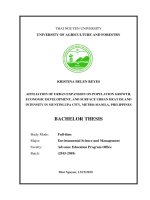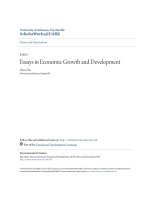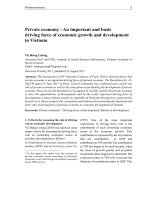Economic growth and economic development 718
Bạn đang xem bản rút gọn của tài liệu. Xem và tải ngay bản đầy đủ của tài liệu tại đây (97.44 KB, 1 trang )
Introduction to Modern Economic Growth
(1) Denote the unskilled wage by w (t) and the skilled wage by v (t). Show that,
as long as v (t) is sufficiently larger than w (t), the instantaneous profits of
a monopolist producing skill-intensive and labor-intensive goods are
v (t) H
1
1 w (t) L
and πl (t) =
π h (t) =
ε − 1 n (t) − m (t)
ε − 1 m (t)
where L is the total supply of unskilled labor and H is the total supply of
skilled labor. Interpret these equations. Why is the condition that v (t) is
sufficiently larger than w (t) necessary?
(2) Define a balanced growth path equilibrium as an allocation where n and m
grow at the same rate g (and output and wages grow at the rate g/ (ε − 1)).
Assume moreover that a firm that undertakes R&D to replace the skill-
intensive good has an equal probability of replacing any of the existing
n − m skill-intensive goods. Show that the balanced growth path has to
satisfy the following condition
wL
vH
=
(1 − µ) (r + λ − (1 − µ) λ/µ)
(r − (1 − µ) λ/µ) µ
where µ ≡ m/n and λ ≡ m/
˙ (n − m) = gµ/ (1 − µ). [Hint: Note that a
monopolist producing a labor-intensive good will never be replaced, and its
profits will grow at the rate g (because equilibrium wages are growing). A
monopolist producing a skill-intensive good faces a constant flow rate of
being replaced, and while it survives, its profits grow at the rate g.]
(3) Using consumer demands over varieties (i.e., the fact that y (ν, t) /y (ν 0 , t) =
(p (ν, t) /p (ν 0 , t))−1/ε ), characterize the balanced growth path level of µ.
What is the effect of an increase in H/L on µ? Interpret.
704









